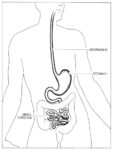The Inner Ear and Its Connection to the Brain
The inner ear, also known as the labyrinth, is a complex structure that plays a crucial role in our ability to hear and maintain balance. It is the deepest part of the ear, located in a small cavity within the skull bones on both sides of the head.
Anatomy of the Inner Ear
The inner ear consists of three main parts:
1. Cochlea: This is the auditory area of the inner ear that changes sound waves into nerve signals. It is shaped like a snail’s shell and filled with fluid. Inside the cochlea is a sensitive structure called the organ of Corti, which contains tiny hairs that pick up the vibrations from sound waves.
2. Semicircular Canals: These canals sense balance and posture to assist in equilibrium. They are filled with fluid and lined with fine hairs, similar to the cochlea, but these hairs pick up body movements instead of sounds.
3. Vestibule: This is the area of the inner ear cavity that lies between the cochlea and semicircular canals, also assisting in equilibrium.
Function of the Inner Ear
The inner ear has two main functions: hearing and balance.
*Hearing*: The cochlea works with parts of the outer and middle ear to help us hear sounds. Sound waves travel from the outer ear to the eardrum in the middle ear, causing it to vibrate. This vibration moves the three tiny bones in the middle ear, leading to pressure waves that make the fluid inside the cochlea move. The movement of fluid in the inner ear makes the tiny hairs in the cochlea bend and move. These “dancing” hairs convert the movement from sound waves into electrical signals.
*Balance*: The balance parts of the inner ear are the vestibule and the semicircular canals. The semicircular canals sit at right angles to each other, which helps them measure motions no matter what position you’re in. When your head moves around, the fluid inside the semicircular canals shifts around.
Connection to the Brain
The electrical signals generated by the inner ear are sent to the brain through the hearing (auditory) nerves. The brain then interprets these signals, allowing us to hear and understand sounds. At the same time, the inner ear monitors our movements, alerting the brain to changes so it can let our body know what to do to stay balanced.
Conclusion
The inner ear is a remarkable structure that not only enables us to hear the world around us but also helps us maintain our balance. Its intricate design and function illustrate the complexity of the human body and the importance of maintaining ear health. Problems with the inner ear can result in hearing loss and balance issues, highlighting the critical role it plays in our daily lives..



